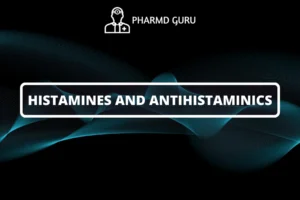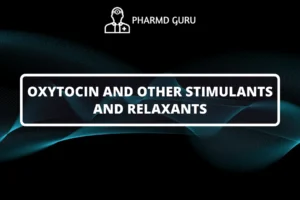(5-HYDROXYTRYPTAMINE) SEROTONIN AGONISTS AND ANTAGONISTS
5-Hydroxytryptamine (5-HT), also known as serotonin, is a neurotransmitter that plays a crucial role in regulating various physiological processes in the body. Drugs that interact with the 5-HT system can have significant effects on mood, behavior, and other functions. In this article, we will explore the pharmacology of 5-HT agonists and antagonists, including their mechanisms of action, therapeutic applications, and considerations for use.
SCROLL DOWN TO THE BOTTOM OF THIS PAGE FOR ACTUAL NOTES.
5-HT Agonists
5-HT agonists, also referred to as serotonergic agonists, are medications that stimulate the activity of 5-HT receptors. They mimic the effects of serotonin and can exert a wide range of physiological and pharmacological actions.
Mechanism of Action
By binding to specific subtypes of 5-HT receptors, 5-HT agonists activate intracellular signaling pathways, leading to various physiological responses. The specific effects depend on the receptor subtype being targeted. Some commonly used 5-HT agonists include:
- Triptans: These medications, such as sumatriptan, are primarily used in the treatment of migraine headaches. Triptans selectively activate 5-HT1B/1D receptors, leading to vasoconstriction and the alleviation of migraine symptoms.
- Selective Serotonin Reuptake Inhibitors (SSRIs): While SSRIs are primarily known as antidepressants, they also have 5-HT agonist properties. By inhibiting the reuptake of serotonin in the brain, SSRIs increase serotonin levels and enhance its neurotransmission, which helps alleviate symptoms of depression and other related disorders.
Therapeutic Applications
The therapeutic applications of 5-HT agonists include:
- Migraine Treatment: Triptans are highly effective in relieving acute migraine attacks by constricting blood vessels and reducing inflammation in the brain. They can also help alleviate associated symptoms such as nausea and photophobia.
- Depression and Anxiety: Selective serotonin reuptake inhibitors (SSRIs) are widely prescribed for the treatment of depression, anxiety disorders, and other mood-related conditions. By enhancing serotonin levels, these medications help stabilize mood and improve overall well-being.
5-HT Antagonists
5-HT antagonists, also known as serotonergic antagonists, block the activity of 5-HT receptors and inhibit the effects of serotonin. These drugs are used for various therapeutic purposes and can have different receptor selectivities.
Mechanism of Action
By binding to 5-HT receptors, antagonists competitively inhibit the binding of serotonin and prevent its downstream effects. Some commonly used 5-HT antagonists include:
- Antipsychotics: Certain antipsychotic medications, such as risperidone and olanzapine, have 5-HT2A receptor antagonist properties. By blocking these receptors, they can help alleviate symptoms of psychosis and schizophrenia.
- Antiemetics: Some 5-HT3 receptor antagonists, including ondansetron and granisetron, are effective in preventing nausea and vomiting associated with chemotherapy and post-operative procedures. These drugs block the action of serotonin in the gut and the brain’s vomiting center.
Therapeutic Applications
The therapeutic applications of 5-HT antagonists include:
- Psychiatric Disorders: Antipsychotic medications that antagonize 5-HT2A receptors are used in the treatment of psychotic disorders, such as schizophrenia, where abnormal serotonin signaling is implicated.
- Nausea and Vomiting: 5-HT3 receptor antagonists are commonly prescribed to prevent and manage chemotherapy-induced nausea and vomiting. They can also be used in post-operative settings to prevent these symptoms.
Considerations and Side Effects
While 5-HT agonists and antagonists have proven therapeutic benefits, they may also be associated with certain side effects and considerations:
- Adverse Effects: Both agonists and antagonists targeting the 5-HT system can have side effects. These may include headaches, dizziness, gastrointestinal disturbances, changes in blood pressure, and mood alterations. The specific side effects can vary depending on the drug and its receptor selectivity.
- Drug Interactions: Some 5-HT agonists and antagonists can interact with other medications, including monoamine oxidase inhibitors (MAOIs), selective serotonin reuptake inhibitors (SSRIs), and certain cardiovascular drugs. It is important to consult a healthcare professional or pharmacist for a comprehensive review of potential drug interactions.
- Individual Variations: Each person may respond differently to 5-HT agonists and antagonists due to genetic variations and individual differences in receptor sensitivity. The dosage and response to these drugs may need to be tailored to each patient.
ACTUAL NOTES:




